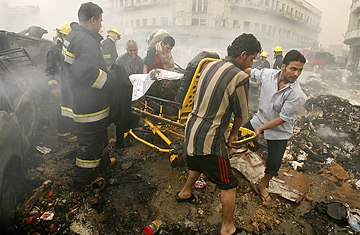
Iraqi firefighters evacuate a burned body from the site of a car bomb explosion at a market in Baghdad's al-Sadriyah neighborhood, April 18, 2007.
But the surge in killings has little to do with the U.S. military strategy, and everything to do with the absence of a viable U.S. — or Iraqi — political strategy.
The major reason that the sectarian violence levels are down may be that the Shi'ite Mahdi Army, perpetrator of much of the worst sectarian killing, has decided for tactical reasons to lie low. Its leader, Moqtada al-Sadr, and his allies in Iraq's government appear to have decided that they're better off waiting out the U.S. surge rather than trying to fight it head-on. After all, they dominate several of Iraq's key ministries and many of its military and police units. If and when the Americans leave, they hope to be well positioned to pursue their goals both politically and militarily.
The Mahdi Army is also able to use its political clout to insulate it from the worst effects of the troop surge, by pressuring the government of Prime Minister Nouri al-Maliki to limit how and where American troops operate in Shi'ite areas. When they feel the heat from the Americans, they are able to make life difficult for al-Maliki by precipitating political crises — as they did this week by announcing the withdrawal of their ministers from his cabinet in protest at his failure to demand a timetable for U.S. withdrawal from Iraq.
But the Sunni insurgency has neither a stake in the government nor a single, top-down leadership structure. And, while death squad violence against Sunnis has declined, there is no sign of a corresponding rise in Sunni participation in the political process. The national government and its ministries are still dominated by Shi'ites, who vastly outnumber Sunnis in the Iraqi security forces. For many Sunnis, the Baghdad security plan simply raises the specter of Shi'ite harassment, oppression and murder.
Sunni rejectionists — hard-core Baathists, local Islamists and foreign jihadists — and their allies have encouraged the political isolation of their community from the political process, and they reap its benefits. Operating on the assumption proven in Sunni minds by events of recent years that they will be oppressed, or worse, in a Shi'ite-dominated Iraq, many Sunnis are willing to tacitly or actively support violence by Sunni militants and terrorists. So, the militants have the popular support that is the lifeblood of any insurgency because it allows fighters to camouflage themselves in the civilian population. Political sentiment in the Sunni communities leaves the U.S. military and the Shi'ite-dominated Iraqi government forces largely unable to procure the intelligence required to isolate and destroy their hidden tormentors in Baghdad.
While the Mahdi Army's tactical response to the surge has been — with some notable exceptions — to avoid being drawn into head-on fights they can't win against superior U.S. firepower, the Sunni insurgents have responded by redeploying many of their fighters outside of Baghdad in search of softer targets. Spreading their forces, for example to the eastern province of Diyala, makes it necesssary for the U.S. to spread its own forces. The U.S. has reinforced Diyala's capital, Baquba, with a Stryker brigade of some 2,000 to 3,000 men. But with the Army's manpower already stretched to the limit, those reinforcements aren't being brought in from the rear; they're being pulled out of Baghdad.
Both the Mahdi Army and the Sunni insurgents are working from the classic guerrilla warfare playbook: avoid confrontations with concentrations of better-armed enemy forces; lie low or mount attacks elsewhere to stretch his forces. It's been this way, in one form or another, since the insurgency began in the summer of 2003. And it's a reminder that no matter how thoughtful and well-executed the military strategy is, its effectiveness will be determined by the political reality.
